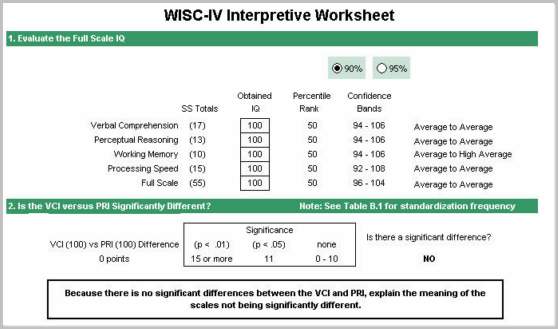
The Wechsler Adult Intelligence Scale-IV (WAIS-IV) is an IQ test that is given by psychologists and measures global intellectual functioning. It includes both verbal and nonverbal components. The average score for all tests and subtests is 100; thus, a score of over 100 is above average and below 100 is below average.
The standard deviation for IQ results is 15, which means that about 68% of scores fall between 85 and 115. The test results also provide the raw and scaled score for each test, as well as a percentile rank.
Basic Scores

The examinee is given three basic scores: Verbal IQ, Performance (nonverbal) IQ, and Full Scale IQ. Tests are further broken down into Verbal Comprehension, Perceptual Reasoning, Working Memory, Processing Speed, and Full Scale IQ. The Verbal Comprehension score measures verbal reasoning and concept formation.
Perceptual Reasoning measures nonverbal learning, including visual perception and coordination. Working Memory is the examinee’s ability to sustain attention and concentration. Finally, Processing Speed is how quickly the examinee can process routine information such as reading and reasoning.
Analyzing Scores
The first step in analyzing scores is to look at the WAIS Composite Scores for the broadest topics. The Composite Score is the IQ, where the average score is 100. Anything from 90 to 109 is considered Average. Score from 110 to 119 are considered High Average, from 120 to 129 are Superior, and from 130 and up are Very Superior.
On the other end of the spectrum, from 80 to 89 is considered Low Average, 70 to 79 is Borderline, and 69 and below are Extremely Low.
The next column is usually the Percentile Ranking. The highest possible score here is 99.9%. The average percentile is 50%, so a percentile of 50 would equate to an IQ of 100. This score will show how the examinee did on the test compared to other people his age. If the percentile is 60, for example, he did better than 60% of others who were tested using the WAIS.
The 95% Confidence Interval is a statistical way of saying the results sometimes might not be accurate. This statistic says that when taking the test, 95% of the time the results will be in the spectrum given. Five percent of the time the results might be outside of the given interval. In other words, the score is about 95% accurate, which is very good for an IQ and performance test like the WAIS.
The last column of the WAIS results is simply the Average, High Average, Borderline, etc. description of the test scores.
Subtests
The WAIS report will then break down the different subtests. The first score is the raw score, or how many the examinee got correct. The second score, though, is the important one. This one is scaled for the person’s age. Similar to the IQ scores, the subtest scores are labeled Borderline for 5 and below, Low Average for 6-7, Average for 8-11, High Average for 12-13, Superior for 14-15, and Very Superior for 16 and up.
Next is the percentile rank, which is the same as for the IQ scores. The subtests do not have the labels such as Average and High Average, but using the chart above, the reader can translate the Scaled Score to its label.
Strengths and Weaknesses
Once the scores are interpreted, the next step is to check for strengths and weaknesses. First, any score below an IQ of 100 should be looked at. These areas are weaknesses compared to others of the examinee’s age. Difficulties in Working Memory and Processing Speed can slow down an individual’s progress even with very high scores in the other two areas. These problems can be frustrating, as the intelligence is there but is not as easily expressed.
Next, check for scores that are lower than the other scores. This indicates a personal weakness, even if the score is still in the Average range. Also check for scores that are higher than the others, as this indicates a personal strength. Once strengths and weaknesses are established, they can be worked on or played to.
The WAIS is a very valuable test. Once it is understood, the information discovered in the WAIS can help people understand their strengths and weaknesses, which is the first step in improving understanding and knowledge.

